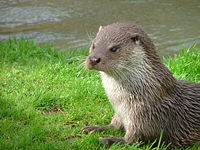Troubles Ahead? by Fred Crouch
The full impact of the programme to reintroduce and assist spread of otters across our waterways has yet to be felt although many highly disturbing incidents are being reported on an increasingly regular basis. In my opinion this is a multi-facetted and extremely serious situation with some aspects not yet fully considered. The first and obvious concern is the direct killing of fish, including barbel where present. But here are some other issues that are equally worrying though kept somewhat in the shadows by the enormity of direct predation.
There is no doubt that far more otters have and will continue to populate our waters than would ever normally exist in their pre-programme habitats. The claim that each individual needs many miles of bank is based on rivers that have had historically low fish populations. They have now been established on rivers where anglers, angling clubs and other agencies have worked hard to encourage high populations! Why would these fearsome, top of the food chain predators need to cover five or six miles of river bank while they have all they need on their doorstep? A predators ‘territory’ is directly linked to food availability. That is a fact displayed throughout the animal kingdom from birds of prey to big cats. This over-population will continue and even increase and only begin to decline in line with diminishing fish stocks.
Another aspect which will impact on the angler is the very presence of otters. Swims that regularly hold good numbers of fish will quickly become the target of these large mammals just as shoals of silver fish attract pike. The result will be dispersal as each barbel seeks personal safety. An otter simply moving through an established swim on a regular basis will cause the fish to desert the area, maybe permanently. As these fish will probably seek some protective cover it would make sense to fish for them there. Areas such as weed beds and in-stream tree growth would at least make the fish feel a little safer. Frightened barbel are almost impossible to tempt with a bait so if otters are nearby the angler will almost certainly struggle for a bite.
Now for a third problem and one that may well have the greatest impact. Between mid-March and mid-June when the barbel gather up to spawn and the angler traditionally keeps his distance the normally suspicious and highly observant otters will, in the main be left will be left undisturbed to harass the fish to their hearts’ content. Even if they killed only one or two fish their presence will ensure that all spawning attempts will be aborted.
Our rivers are under threat as never before and things are much different to those in my earliest days. Generally lower levels as a result of more efficient drainage and natural bank erosion and future use as green energy sources look towards hydro-electric schemes. And then course the spread of mink cormorant, signal crayfish and now otters. As I entered the sport of angling it appeared all the fish had to worry about was the heron and kingfisher but things have changed so much.
However I along with millions of others came through a frightening war and just had to get on with it. As an unshakeable optimist I believe we will see our way through these troubled times. I don’t quite no how yet but I will always believe.
Coming soon, a bit more on signal crayfish.
FRED CROUCH





Leave a Reply